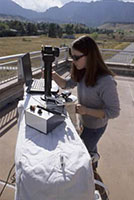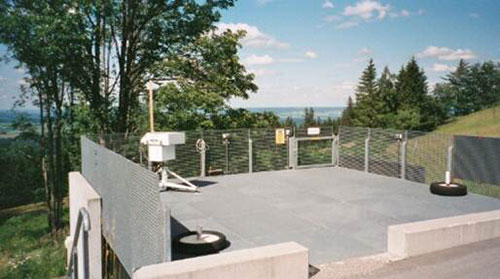Ozone Monitoring in the UK
The following information explains the types of Ozone monitoring in the UK.
Dobson Spectrophotometer
 This ground-based instrument measures column ozone by the technique of differential absorption of ultraviolet (UV) light with the sun (or moon) as a light source. By comparing the UV light intensity at wavelengths that are strongly absorbed and weakly absorbed by ozone, the column ozone content of the atmosphere is accurately determined.
This ground-based instrument measures column ozone by the technique of differential absorption of ultraviolet (UV) light with the sun (or moon) as a light source. By comparing the UV light intensity at wavelengths that are strongly absorbed and weakly absorbed by ozone, the column ozone content of the atmosphere is accurately determined.
Brewer Spectrophotometer
 This measures ozone and sulphur dioxide by examining the absorption of specific ultraviolet wavelengths from the solar spectrum. Incoming light is directed through the foreoptics using a prism, which may be rotated to select light from either the direct sun, the zenith sky, or one of the two calibration lamps. A grating spectrometer disperses ultraviolet light onto a focal plane, in which six exit slits are positioned at the operating wavelengths: 303.2 nm (for mercury lamp wavelength calibration), 306.3 nm, 310.0 nm, 313.5 nm, 316.8 nm and 320 nm. The wavelength resolution is 0.6 nm. The Brewer is housed in a durable weatherproof container, and is designed for continuous, automated outdoor operation, and can therefore operate reliably over a wide range of temperature and humidity conditions.
This measures ozone and sulphur dioxide by examining the absorption of specific ultraviolet wavelengths from the solar spectrum. Incoming light is directed through the foreoptics using a prism, which may be rotated to select light from either the direct sun, the zenith sky, or one of the two calibration lamps. A grating spectrometer disperses ultraviolet light onto a focal plane, in which six exit slits are positioned at the operating wavelengths: 303.2 nm (for mercury lamp wavelength calibration), 306.3 nm, 310.0 nm, 313.5 nm, 316.8 nm and 320 nm. The wavelength resolution is 0.6 nm. The Brewer is housed in a durable weatherproof container, and is designed for continuous, automated outdoor operation, and can therefore operate reliably over a wide range of temperature and humidity conditions.
Dobson Units
Ozone is measured in Dobson Units. If all the ozone in a column above the earth were to be compressed to standard temperatue and pressure (0 deg C and 1 atmosphere pressure) and spread out evenly over an area to a thickness of 0.01 mm this would be equivalent to one Dobson Unit(DU), i.e 300 DU would form a slab approximately 3mm thick. This unit is named after G. M. B. Dobson, one of the first scientists to investigate atmospheric ozone and the designer of the Dobson spectrometer.
